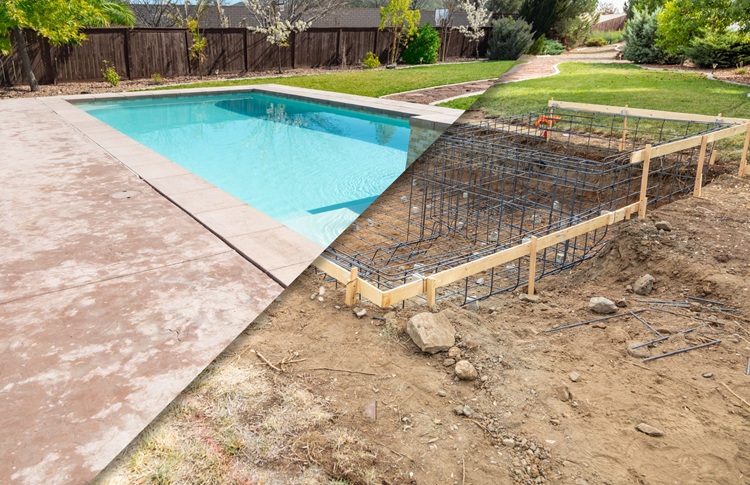Swimming pool construction on sloped terrain brings its own set of physical and structural challenges. Sloped land requires additional planning and groundwork when compared to flat surfaces. These difficulties usually arise during the excavation stage, and if not addressed correctly, they can delay or even halt the project.
Let us look at the most common excavation issues that occur while constructing a swimming pool on sloped ground and how to address them.

Unstable Soil Conditions
One of the main problems with sloped terrain is soil instability. Loose or shifting soil can cause the walls of the excavation to collapse. This becomes more likely when the slope has soft soil or has been affected by rain.
Excavating under these conditions demands extra support. If the walls are not strong enough, they may cave in during or after the digging process. This can damage construction equipment or injure workers.
Fix
Use retaining walls or shoring techniques to keep the soil in place during excavation. In cases of heavy soil movement, it may be necessary to bring in soil reinforcement materials. Also, digging in smaller sections helps reduce pressure on the slope.
Access Limitations for Equipment
Sloped terrain limits the movement of heavy machinery. Excavators and loaders may not have enough space to move around safely or operate efficiently on an incline. This can slow down the construction process and may require additional effort.
Fix
Use compact excavation equipment designed for tight or sloped spaces. These machines can handle the terrain better than larger ones. You can also create a temporary ramp or staging area to help move machines safely in and out of the construction zone.
Drainage Problems
Water naturally flows downhill. During swimming pool construction on a slope, this can lead to water pooling in the excavation area. Standing water creates a muddy base that affects soil stability and slows down work.
Fix
Create temporary trenches or channels that direct water away from the dig site. You can also use sump pumps to remove collected water. Managing water flow from the start will help keep the work area dry and safe.
Excavation Depth Control
Maintaining a consistent depth becomes harder on uneven ground. The slope may require different cut levels, which can lead to misalignment and uneven pool walls if not done correctly.
Fix
Mark the elevation levels clearly before starting the excavation. Use laser levels or transit levels to check the depth during digging. This avoids over-digging or under-digging, both of which can affect the pool’s structure.
Extra Excavation Volume
Due to the slope, the amount of soil that needs to be removed is often greater than expected. This extra digging leads to more time, more effort, and more costs. In some cases, part of the slope has to be carved out entirely.
Fix
Measure and plan the excavation zone carefully. Estimate the soil volume that must be removed based on the slope’s angle and the pool size. This helps prepare for the additional workload and equipment needs.
Soil Disposal Issues
Removing more soil than planned means you have to deal with a large volume of earth. On sloped terrain, it is even harder to find a place to temporarily store this soil. Piles may slide or fall if not placed correctly.
Fix
Transport the soil offsite regularly during the digging process. If temporary storage is necessary, level a small area nearby and compact it before stacking the soil. This reduces the risk of soil piles shifting.
Potential Erosion
Once the excavation begins, exposed soil on a slope becomes more likely to erode. Wind and rain can carry away loose soil, especially in areas without any cover or protection. This might also affect nearby structures.
Fix
Use tarps or erosion control blankets to cover exposed areas. Installing straw wattles or barriers along the slope helps reduce erosion. Replacing vegetation or adding a protective layer after excavation is also helpful.
Conclusion
Swimming pool construction on sloped terrain requires more than just digging a hole. From soil shifts to drainage complications, several challenges arise during excavation. By identifying these problems early and applying proper solutions, you can move the project forward with fewer setbacks. Although the slope presents hurdles, planning ahead with the right steps can lead to a successful build.
